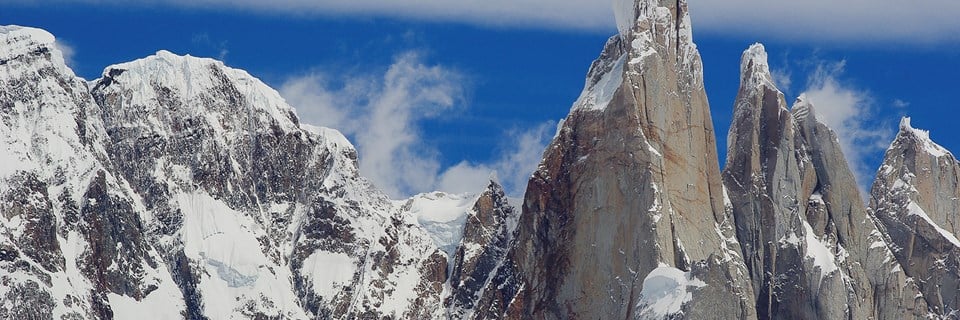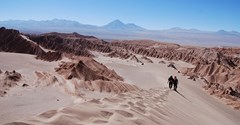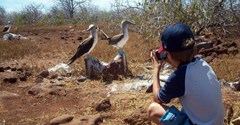From the icy waters of Patagonia to the misty cloud forests of the equator, journey along the world's longest mountain range.
The Spine of South America
Stretching almost the entire length of South America, the landscapes along the Andes encompass icy fjords, magnificent granite spires, sparkling blue lakes, pristine vineyards, expansive salt flats, Mars-like deserts, remote Quechua villages and misty cloud forests full of exotic flora. Along the way lies the world's southernmost city and highest capital, its driest non-polar desert, highest and largest salt flat, highest geyser field and highest navigable lake.
Majestic condors, reclusive pumas, remote penguin colonies, beautiful hummingbirds and hardy llamas and alpacas are just a small selection of the wildlife that inhabit these often harsh environments. Meanwhile the exploits of explorers are preserved for prosperity in the names you will encounter on your travels; the Staits of Magellan, Drake's Passage and the Hiram Bingham train, not to mention the rich seam of Colonial heritage left since the 16th century Spanish invaders eventually found their way to the mountain cities of the Andes.
The recent BBC Two Mountain Life at the Extreme programme beautifully and thoughtfully took viewers on a 4,000 mile panoramic journey up the length of the Andes, showcasing the extraordinary diversity and beauty of the world's longest mountain chain. For many, it would have been an illuminating and inspirational hour of television and so inspired us to take our own digital journey along the Andes, featuring some of the places visited in the show and one or two others to further enrich your experience.
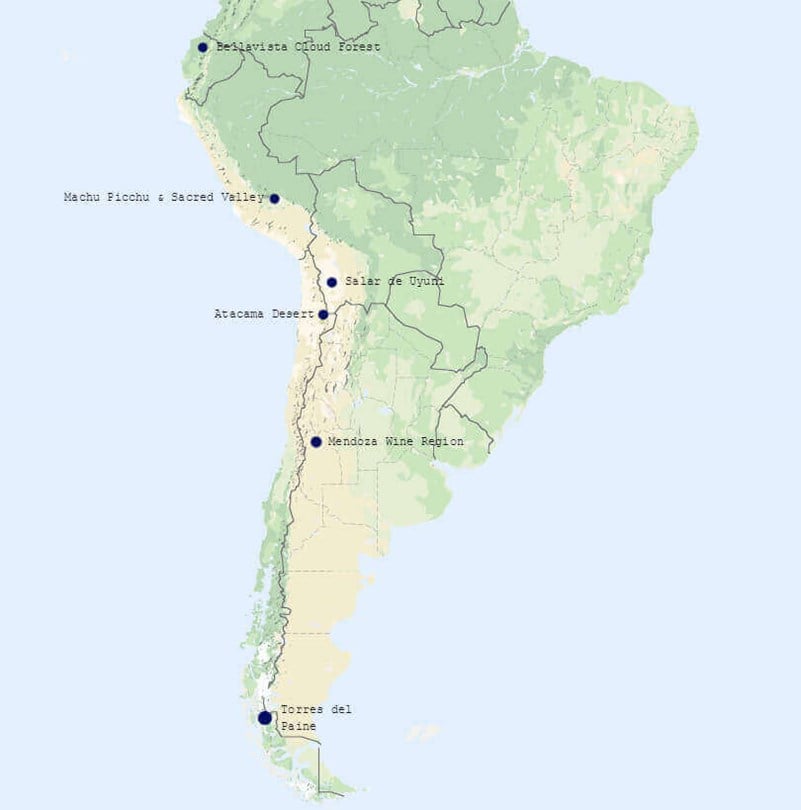
Granite peaks & icy waters of Southern Patagonia
Our journey starts way down south, where the Andes rise out of (or sink into, depending on the direction) the icy waters of the Straits of Magellan in Tierra del Fuego. The peaks here are rugged, jagged and often covered in glaciers and interspersed with lakes and fjords. The conditions are harsh, yet life thrives here and the landscapes are breathtaking.
The most popular destination in Southern Patagonia is the Torres del Paine National Park in Chile, regarded as one of the continent's very best parks. Towering granite spires overlook turquoise lakes and powerful waterfalls, Andean condors soar high above and the immense Glacier Gray spreads out over 100 square miles and tumbles into the lake of the same name. The park is perhaps best explored on a three night stay from one of the specialist lodges, heading out to undertake horse-rides, boat trips or hikes of varying lengths and difficulties.
In the extreme south, specialist expedition cruises explore the myriad of channels, islands, glaciers and bays of Tierra del Fuego in Chile and Argentina. Three hours across the border from Torres del Paine is El Calafate - base for visits to the magnificent Perito Moreno Glacier, hikes to a condor nesting site and boat trips to more remote glaciers. From here it is another three hour drive around Lake Argentina and Lake Viedma to El Chalten, another popular centre for full day hikes and horse-riding amid the spectacular Patagonian scenery around Mount Fitzroy and Cerro Torres.
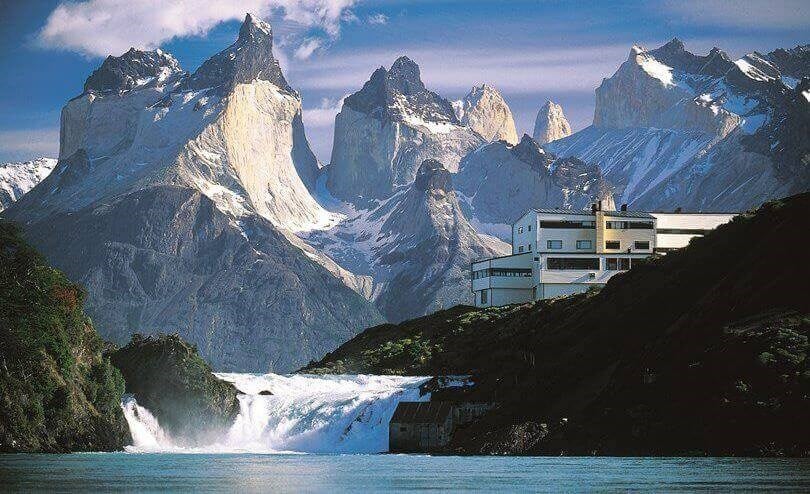
Torres del Paine National Park in Southern Chile
Prized Vineyards of Central Chile & Argentina
Travelling north, passing the Germanic towns, glistening lakes and conical volcanoes of the Lake District, brings us to Central Chile and the Central Valley wine region around the capital Santiago. Full day excursions from Santiago allow you to thoroughly explore some of the region's most prized and historic vineyards, touring the vines and the winery and sampling some of the finest vintages.
One of the most well known regions is the Maipo Valley, which actually stretches from the foot of the Andes across Chile to the Pacific coast. Lots of sunshine and cool night temperatures allow the grapes to slowly ripen, conditions which make for some particularly good Cabernet Sauvignon. The Casablanca Valley, to the west of the capital, is best known for its Sauvignon Blancs, the result of foggy mornings and coastal winds. Smaller wineries thrive in the Aconcagua Valley, overlooked by the highest mountain in the Andes, indeed the highest outside of Asia.
Over the Andes in Argentina is Mendoza, another renowned wine-producing region. Boutique hotels offer visitors immersive experiences, affording the chance to base yourself in functioning wine estates.
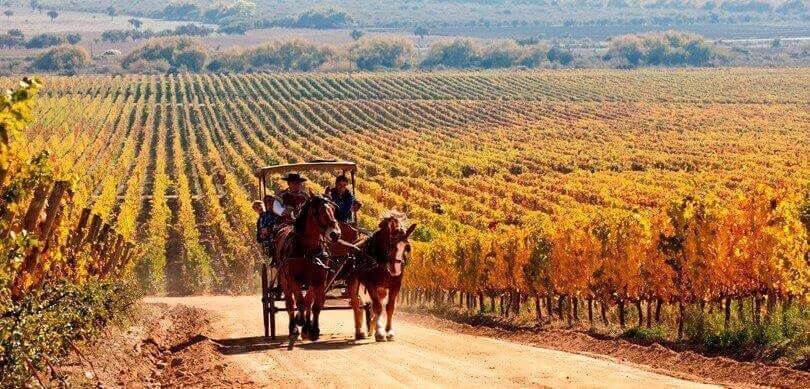
Central Valley vineyard during autumn in Chile
Arid Deserts & Geysers of Northern Chile
The next stop on our journey is the small town of San Pedro de Atacama in Northern Chile, from where you can head out on a number of diverse excursions to explore the otherworldly environments of the Atacama Desert, almost entirely bereft of rainfall. One of the most popular of these is a visit to the cinematic Moon and Death Valleys; areas of often Mars-like landscapes characterised by immense and vividly-named rock formations, dusty roads and sweeping sand dunes. The valleys are best experienced in the late afternoon and early evening as the setting sun bathes the landscape in a soft red hue and creating conditions which are perfect for photography.
Further afield are the extraordinary El Tatio Geysers, where more than 80 geysers erupt simultaneously to form a surreal sight as the first rays of the sun come up. The geysers operate at their peak output during only a short window around sunrise and so you need to set your alarm clocks early for the long and bumpy ride up to an altitude of over 4,300 metres and also withstand freezing early morning temperatures, but few places will leave such an impression on you. If you prefer late nights to early mornings then you might take more pleasure in indulging in the world class stargazing which can be undertaken near to San Pedro. The combination of clear nights, lack of light pollution and some of the world's most powerful telescopes allows you to peer deep into the night sky, seeing the rings of Saturn perhaps.
The Atacama also has its own immense salt flat, which can be visited from San Pedro. Such a natural phenomenon is a particular trait of this part of the Andes, as we will discover in more detail in our next destination...
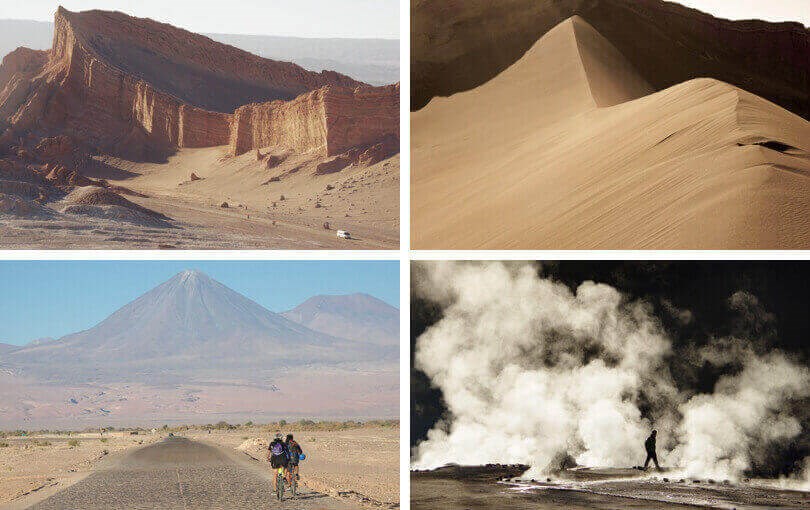
Moon Valley & El Tatio Geysers, Atacama Desert
Altiplano Landscapes of Bolivia
Travelling north-east of the Atacama brings us onto the biggest high plateau along the Andes - the Altiplano. This immense basin area, which encompasses salt flats, lakes, lagoons, volcanoes and towering peaks, was formed when the Andes Mountains rose up out of the earth as the floor of the Pacific Ocean crashed against South America.
A huge pre-historic lake took form here, spread out over 4,000 miles in total. Over centuries it was to evaporate and leave behind a thick crust of salt that became the world's largest and highest salt flat - the Salar de Uyuni. The immense white expanse is surrounded by shadowy blue mountains in the distance, save for stretches where nothing rises out of the earth to disturb the empty, endless horizon. In the middle of the salt flat is the cactus-covered Isla de los Pescadores, a refuge in Inca times for those fleeing from the Spanish, confident their horses would struggle to traverse the salt. On the edge of the salt flat is the Uyuni Train Cemetery, a melancholy collection of decaying British-built locomotives, which stand as a monument to Bolivia's mining industry. The BBC Two programme showed Uyuni after the wet season, when a shallow film of water turns the salt flat into the world's biggest mirror. The resultant landscape is surreal, however do bear in mind that visiting at this point can make it harder to reach further into the Salar and some routes can become blocked.
The Salar can be explored in a day via 4x4, but between it and the Atacama Desert lie a series of shimmering high altitude lagoons of all shapes and colours and where Andean flamingos gather to feed in the shallow waters. The lonely track leads north past the extraordinary Sol de Manana geothermal field, the surreal Salvador Dalí Desert, roaming guanacos and the bizarre Stone Tree, reaching altitudes of 5,000 metres along the way.
Continuing north of Uyuni, via the bustling streets and intriguing markets of La Paz, we reach the sacred blue waters of Lake Titicaca - home to timeless Andean communities preserving their unique ways of life. From here, we now cross into the fourth and penultimate country of our journey - Peru.
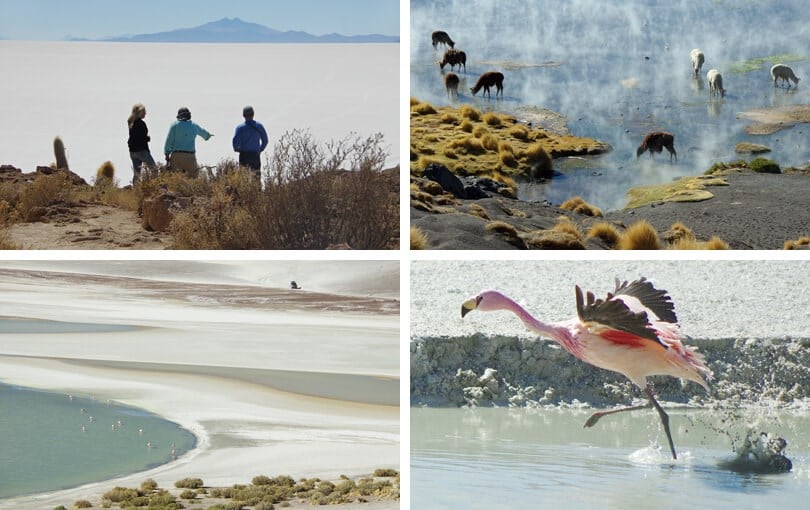
Uyuni Salt Flat, Laguna Colorada, Laguna Honda & Andean Flamingo in Bolivia
Inca Heritage & Andean Villages of Peru's Sacred Valley
From Lake Titicaca we now head up through Peru's Inca heartland and arrive at the Sacred Valley, formed by the mighty Urubamba River. This area has a rich history of human settlement, with breathtaking hilltop fortress ruins, ancient salt ponds and high altitude trails revealing the remarkable achievements and daily lives of the Incas, who used the valley as their stronghold. The remote villages preserve traditional mountain life, farming and weaving techniques and local markets. One of the best places to see the Andean village life featured in the programme is Willoq, known for the quality of its weavings and textiles.
Of course, another place given prominence in the documentary was the lost Inca citadel of Machu Picchu, buried deep in misty cloud forest amid steep valley gorges and terraced slopes. A visit here is one of the highlights to any South American holiday, affording the chance to see the wonderous engineering capabilities of the Inca civilization first hand. Machu Picchu can only be reached by taking one of the trains from Cusco or the Sacred Valley, followed by a short bus ride, or on foot by completing the four day Inca Trail.
Cusco itself is a wonderful city in which grand Spanish churches and buildings were constructed on the foundations of ancient Inca temples. High above the city are the well-preserved remains of Sacsayhuaman fortress complex.
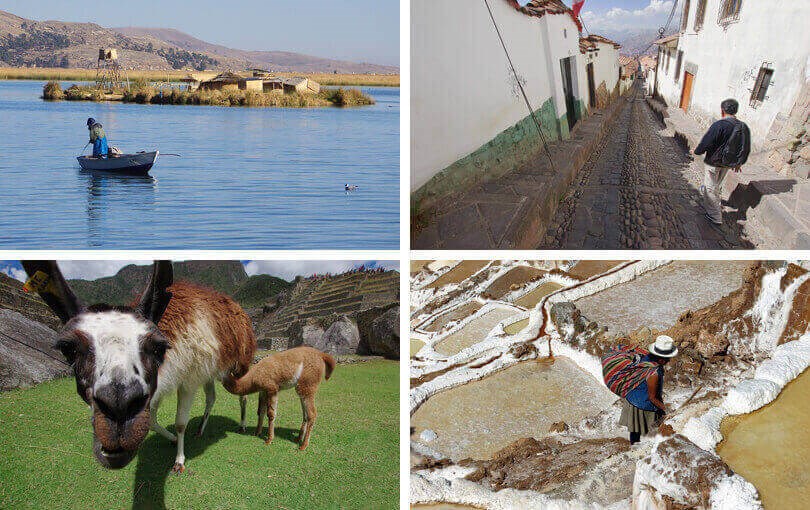
Lake Titicaca, Backstreet in Cusco, Llamas at Machu Picchu & Maras Salt Ponds
Misty Cloud Forests of Ecuador
And so we finish our panoramic tour at the same place the BBC finished theirs. Having started at the end of the world in Patagonia, we end at 0 degrees latitude. Close to Ecuador's capital Quito, an Andean city surrounded by mountains and overlooked by the Pichincha Volcano, are the Bellavista and Mindo Cloud Forests. Both can be visited on a full day trip from Quito, enticing visitors with the promise of magnificent hummingbirds, frogs and butterflies, exuberant vegetation and misty cloud forests. A wide range of plant and bird life can be observed at close quarters and the adaptations required to exist in this cool and wet environment can be understood, thanks to the local guides.
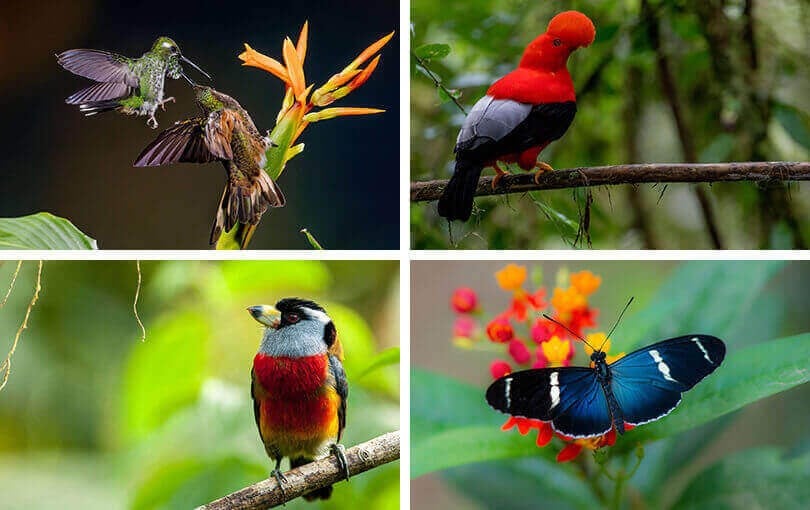
Bird life abounds in the cloud forest around Mashpi Lodge
Do you want to take your own journey up the Andes? We've picked out a few tours that combine some of the places featured here below, all of which can be tailored to suit you. Just give us a call or send us over a quick email to kick off the process!
Choose your perfect holiday
Find inspiration from our selection of itinerary suggestions, a great starting point for your next trip
View More Tours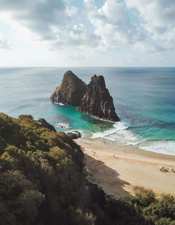
Stay in touch
Infuse your travels, with inspiration from our monthly newsletter.
READY - 12 April 2024
INDIA: Fascinating Culture & Kembh Mela Festival
LANDMARK TOURS: Multi-Country & Cross Continent. New Cosmopolitan Tour: Buenos Aires, Iguazu, Rio
CHINA & INDIA: Local Life, People & Unique Cultures
GUIDES by Veloso Tours, are the best Local Hosts
PRIVATE VILLAS: Quality Time in exclusive settings
TRAVEL INSURANCE with extensive COVID-19 cover
